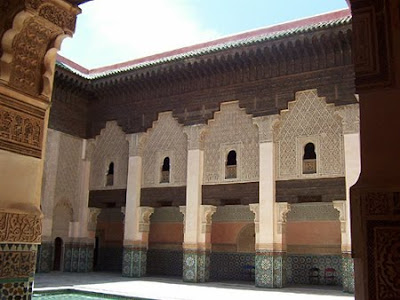
One of the largest buildings in the Medina, and preceded by a rare open space, the Ben Youssef Mosque is quite easy to locate. Its medersa - the old student annexe, and their home until they had learnt the koran bu rote- stands off side street just to the east, distinguishable by a series of small, grilled windows. The entrance porch is a short way down the side street, covering the whole lane at this point. Recently restored, it is open from 9pm to 5pm every day; admission is the standard 10dh.
Like most of the Fes medersas, the Ben Youssef was a Merenid foundation, established by sultan Abou El Hassan in the fourteenth century. It was, howevere, almost completely rebuilt under the saadians, and it is this dynasty's intricate, Andalucian-influenced art that has left its mark. As with the slightly later saadian Tombs, no surface is left undecorated, and the overall quality of its craftsmanship, whether in carved wood, stuccowork or zellij, is startling. That this was possible in sixteenth-century Marrakesh, after a period in which the city was reduced to near ruin and the country to tribal anarchy, is remarkable. Revealingly, parts have exact parallels in the Alhambra Palace in Granada, and it seems likely that Muslim Spanish architects were employed in its construction.
Inside the medersa, you reach the main court by means of a long outer corridor and a small entry vestibule. To the side of this are stairs to student cells, arranged round smaller internal courtyards on the upper floors, an ablutions hall and latrine, still in evil-smelling use. Util very recently, a remarkable tenth-century Ommayad marble basin - decorated with eagles and griffins -completed the ensemble, though it has now been removed to the Dar Si Said museum.
The central courtyard, weathered almost flat on its most exposed side, is unusually large. Along two sides run wide, study, columned arcades, which were probably used to supplement the space for teaching in the neighbouring mosque. Above them are some of the windows of the dormitory quarters, from which you can get an interesting perspective - and attempt to fathom how over eight hundred students were once housed in the building.
At its far end, the court opens onto a prayer hall, where the decoration, mellowed on the outside with the city's familiar pink tone, is at its best preserved and most elaborate. Notable here, as in the court's cedar carving, is a predominance of pinecone and palm motifs; around the mihrab (the horseshoe-arched prayer niche) they've been applied so as to give the frieze a highly three-dimensional appearance. This is rare in Moorish stuccowork, though the inscriptions themselves, picked out in the curling, vegetative arabesques, are from familiar Koranic texts.the most common, as in all Moroccan stucco and zellij decoration, is the ceremonial bismillah invocation: "In the name of Allah, the Compassionate, the Merciful...".

Aucun commentaire:
Enregistrer un commentaire